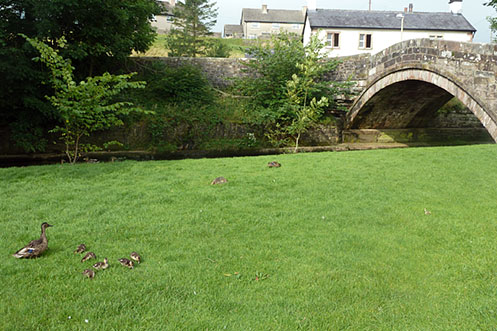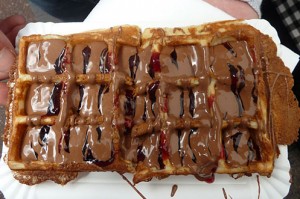Continuing on the trail of the Pendle Witches (click here for my post on the Pendle Sculpture Trail) the final leg of my journey was to Lancaster Castle. It was here that the Pendle Witches were imprisoned and eventually executed on Gallows Hill. What struck me as we made our way towards Lancaster, was just how green the area was. Our guide Anna, from Visit Lancashire, reliably informed me that it’s a myth Lancashire is mainly industrial – it is in fact 80% rural.
On route I managed to catch a fleeting glimpse of Clitheroe Castle which has one of the smallest (if not the smallest) castle keeps in England, which may explain why it was quite difficult to see it from afar. We also stopped off at Dunsop Bridge, officially the centre of the British Isles. And as JRR Tolkein allegedly wrote part of Lord of the Rings in nearby Stoneyhurst College you can see where the concept of Middle Earth may have come from.
Another area of outstanding natural beauty, and one of Lancashire’s hidden gems, is the Forest of Bowland. Part of the Duchy of Lancaster it’s owned by The Queen – her official biographer has mention her (not so) secret desire to retire here – having driven through it I can’t say I blame her. Anna also pointed out the Ashton Memorial, another hidden gem I’d never heard of, and Lancashire’s answer to the Taj Mahal as it was commissioned by Lord Ashton as a memorial to his late wife (it was completed in 1909).
Our final destination, following in the footsteps of the Pendle Witches, was Lancaster Castle. Also owned by The Queen, until fairly recently it was still a prison (there has now been talk of turning this area into a hotel or arts and crafts market within the castle). But it remains a working Crown Court, which is why it’s illegal to take any photographs inside (see my pic below).
Lancaster Castle in itself is a hidden gem in that it’s steeped in history. It’s well worth taking a guided tour to find out in more detail about the fascinating (and gruesome) tales surrounding it. We paid a visit to the criminal court, built in 1795, which became known as the hanging court as only The Old Bailey sentenced more people to death. Here I learned all sorts of interesting trivia, like for example that until 1811 prisoners were branded with the letter M (to symbolise malefactor, evil doer). That’s why people raise their hands when taking an oath in court as it used to be the way a judge and jury could see if the defendant had been previously branded. And we were given a tour of Hadrian’s Tower where a selection of instruments of torture are kept on display.
We were also taken to see the prisoners’ remand cells, the place they were kept before they were lead out to be executed (the last public execution was in 1865 and the last private execution in 1910) which date back from 1780. Here we were informed about the cheery subject of different methods of hanging and the origins of various phrases such as to kick the bucket.
The most famous of all the prisoners kept at Lancashire Castle were the Pendle Witches. We were also lucky enough to be given a private tour of the cell where the Pendle Witches were held prior to their execution on Gallows Hill as it’s not normally open to the public. And we also paid a visit to what’s now the library but would have been the old court room where they were tried.
After being sufficiently creeped out by stories of alleged ghost sightings (I did ask) that include one about a guard on duty who was found hiding under a table after he claimed to have been attacked by a man in a flat cap we headed back into daylight. If you’re a fan of horrible histories and witchcraft, Lancaster Castle is one hidden gem you won’t want to miss. And if that’s not your cup of tea then you’d be hard-pushed not to be spellbound by some of Lancashire’s areas of natural beauty.








